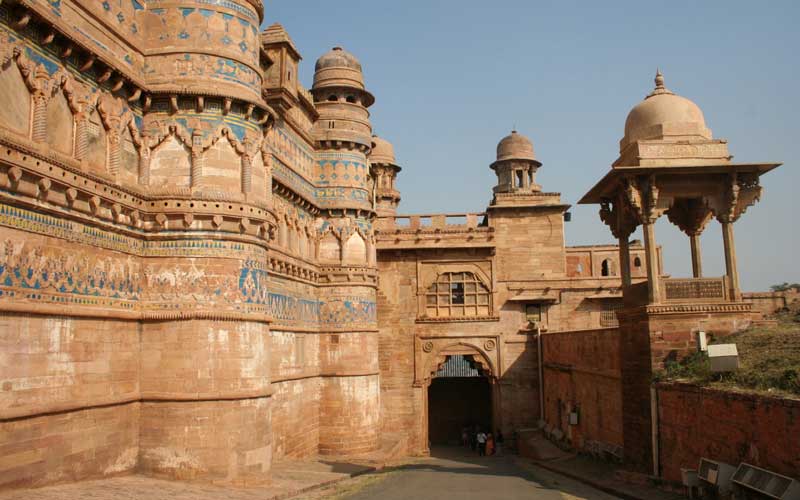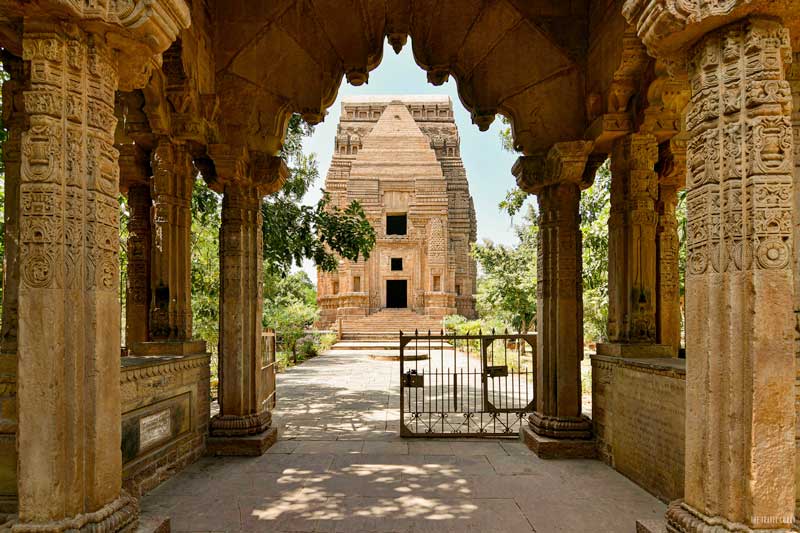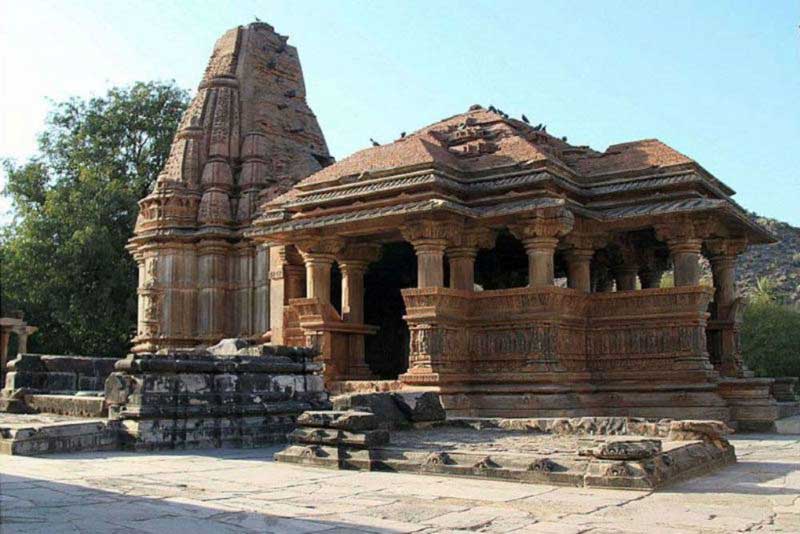
Located on the top of a solitary rocky hill called Gopachal and dominating the city of Gwalior, the massive Gwalior Fort is considered one of the most impenetrable forts in the country. According to a local legend, a saint named Gwalipa cured the local king Suraj Sen of leprosy by sprinkling some water from a sacred pond and as a thankful gesture to the saint, the king named the fort and the city after him. The pond is now located within the fort complex and is known as Suraj Kund. Although there is no documentary evidence to indicate the period of construction of the huge structure, the second oldest record of the symbol of numeric zero was found in the form of a carving in a small temple on the way to the top, which is considered around 1500 years old. Nevertheless, the inscriptions and monuments found within the present fort complex suggest that it existed as early as the beginning of the 6th century, when the Huna emperor Mihiragula or Mihirakula ruled the fort.

Later, the Gurjar-Pratiharas captured the fort in the 9th century and after that, the Muslim dynasties attacked the fort several times from the 11th century onwards. In 1022, Maḥmūd ibn Sebüktegīn, popularly known as Mahmud of Ghazni, the first ruler to hold the title Sultan, besieged the fort for four days. After that, Qutb ud-Din Aibak, a general of Muhammad of Ghori, who later founded the Slave dynasty and became a ruler of the Delhi Sultanate, captured the fort in 1196 after a long siege. However, the Sultanate of Delhi lost the hold of the fort for a brief period, before it was recaptured by Iltutmish in 1232. Subsequently, the fort was captured by the Tomar Rajputs in 1398. Man Singh, who ascended the throne in 1486 AD, was the last and the most distinguished Tomar ruler. He built the defensive structure of the fort, together with the two main palaces, the beautiful turquoise blue-tiled Man Mandir and Gujari Mahal, meant for his wife, Queen Mriganayani.

Although Delhi Sultan Sikander Lodi of the Lodi dynasty tried and failed to capture the fort in 1505, his son Ibrahim Lodi became successful, when he attacked the fort in 1516, resulting in the death of Man Singh and consequently, the Tomars surrendered and lost the fort. After that, the Gwalior Fort witnessed a brief period of rule by the Mughals, until it was captured by the Marathas and soon lost to the East India Company. However, between 1808 and 1844, there were frequent changes in the control of the fort between the Scindias and the British and after the battle of Maharajpur, the fort was occupied by the Gwalior State of the Scindia family in January 1844, as a protectorate of the British government. Nevertheless, when the British were in complete control of India by 1886, they handed over the fort to the Scindia family and they continued to rule Gwalior until the independence of India.

The massive fort, covering an area of 3 sq km and rising 36 feet (11 m), has one gate on the northeast side with a long access ramp and the other on the southwest. While the ornate Elephant Gate or Hathi Pul on the northeast with a long ramp is the main entrance, the gate on the southwest is known as the Badalgarh Gate. The Hathi Pul leads to the Man Mandir Palace, built by Maharaja Man Singh in the 15th century and often referred to as a Painted Palace due to the use of styled tiles of turquoise, green and yellow in a geometric pattern.

The Gujari Mahal, now converted into a museum, was also built by Man Singh Tomar, for the use of his wife Mrignayani, a beautiful Gujar princess, who wished to have a separate palace of her own with a regular water supply through an aqueduct from the nearby Rai River. The other palaces in the fort complex include the Karan Mahal, built by Kirti Singh, the second king of the Tomar dynasty, who was also known as Karn Singh; the Vikram Mahal, built by Vikramaditya Singh, the elder son of Man Singh, which once housed a temple of Lord Shiva, destroyed during the Mughal era; the Jahangir Mahal and the Shah Jahan Mahal.

There are several Hindu and Jain temples in the fort complex, which include the Teli-ka-Mandir, built of red sandstone with elements of stone carving in the Pratihara style of architecture by the Pratihara emperor Mihira Bhoja in the 9th century. With an imposing height of more than100 feet and reflecting a splendid fusion of South Indian architecture with North Indian decorative motifs, the entrance of the temple has an archway with sculpted images of river goddesses, romantic couples, foliate decoration and a Garuda, a divine creature mentioned in the Hindu, Buddhist and Jain beliefs, represented as the vahana or the mount of the Hindu god Vishnu. The temple, originally dedicated to Vishnu, was severely damaged during the Muslim raids and was subsequently restored into a temple of Shiva by installing a Linga, a symbolic representation of the deity. The Garuda Monument, a tall column located close to the temple, was subsequently built by Maharana Jai Singh.

The Sahastrabahu temple, also known as the Sas-Bahu temple, is a twin temple, built in 1092-93 by the Kachchhapaghata Rajput dynasty. The temple, built of red sandstone and dedicated to Vishnu, was badly damaged from numerous invasions and wars in the region and is mostly in ruins. However, although the tower and sanctum of the temple have been destroyed, its architecture and damaged carvings can still be appreciated even from the ruins. While the Sas temple has survived in some form, the Bahu temple is a shell structure of the original one storey structure with a highly ornate door frame and its defaced wall reliefs surviving.

Located around the walls of the Gwalior Fort, the Gopachal temple, also called Gopachal Parvat Jaina monuments, are a group of Jain carvings dated to between the 7th and 15th century, which include around 1500 idols of various sizes, depicting Tirthankaras in seated Padmasana posture as well as standing Kayotsarga posture, in the typical naked form of Jain iconography. Dedicated to the Jain Tirthankaras Adinatha, Mahavir, Neminatha, and Rishanabhanatha, it includes a colossus of Tirthankara Parsvanath in padmasan posture, which is 42 feet in height and 30 feet in breadth. Unfortunately, the monuments were defaced and desecrated around 1527 when the Emperor Babur ordered their destruction. Besides the Gopachal temple, the Siddhachal Jain Temple Caves, built inside the fort in the 7th to 15th century, include eleven Jain temples cut into the rock, dedicated to the Jain Tirthankaras. The monuments include many caves containing small reliefs on the walls, as well as 22 colossi, the largest being the 58 feet 4 inches (17.78 m) tall idol of Rishabhanatha or Adinatha, the 1st Tirthankara.

Apart from the Hindu and Jaina temples, the Gwalior Fort also contains the Gurdwara Data Bandi Chhor, built during the 1970s and 1980s as a memorial for the sixth guru of the Sikhs, Guru Hargobind Sahib. Guru Hargobind Sahib was imprisoned in the Gwalior fort at the tender age of fourteen, along with 52 Hindu kings and princes by the Mughal emperor Jahangir in 1609, on the pretext that the fine imposed on his father, 5th Sikh Guru Arjan Dev had not been paid by the Sikhs. In view of the background relating to the origin of the Gurdwara, it was rightly named, as the word Bandi means imprisoned, while Chhor stands for release.

Today, the Gwalior Fort, referred to as the pearl amongst fortresses in India by Mughal emperor Babur, hosts a spectacular sound and light show every evening, covering the rich history of the fort, along with the love story of Raja Man Singh and his queen Mrignayani.